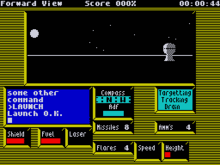This article needs additional citations for verification .(October 2017) |
| Academy | |
|---|---|
 | |
| Developer(s) | CRL Group |
| Publisher(s) | CRL Group |
| Designer(s) | Pete Cooke |
| Series | Tau Ceti |
| Platform(s) | ZX Spectrum, Amstrad CPC, Amstrad PCW, Amiga, Atari ST, MS-DOS |
| Release | 1986 |
| Genre(s) | Action, simulation |
| Mode(s) | Single-player |
Academy is an action/simulation video game for the Commodore 64, MS-DOS, ZX Spectrum, [1] Amstrad CPC, and Amiga [2] It was released in 1986 by the CRL Group. It is the sequel to Tau Ceti and written by the same author, Pete Cooke.
